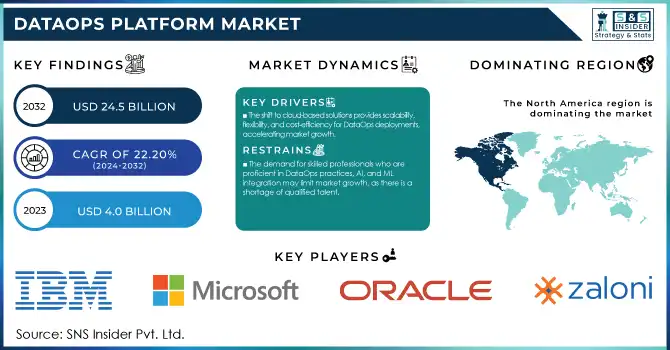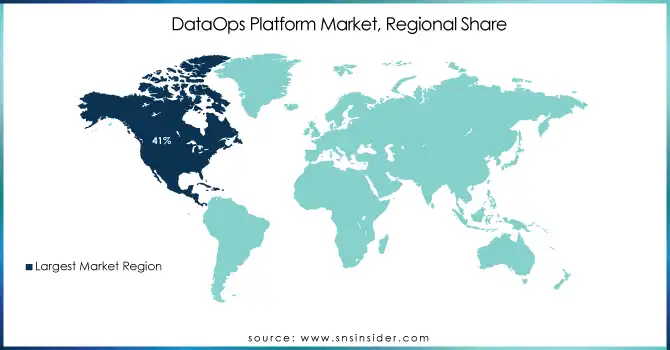DataOps Platform Market Report Scope & Overview:
The DataOps Platform Market was valued at USD 4.0 Billion in 2023 and is expected to reach USD 24.5 Billion by 2032, growing at a CAGR of 22.20% from 2024-2032.

To get more information on DataOps Platform Market - Request Free Sample Report
The DataOps Platform Market is witnessing robust growth, This growth is primarily driven by the increasing volume and complexity of data generated across industries. As organizations encounter difficulties managing vast and diverse datasets, DataOps platforms provide efficient solutions for data integration, processing, and analysis. These platforms address the rising demand for agility in data management, ensuring smooth data flow across various systems. A significant driver of the market’s expansion is the integration of artificial intelligence and machine learning into DataOps platforms. These technologies automate tasks such as data quality management, anomaly detection, and predictive analytics, enabling businesses to enhance data processes and derive insights with greater speed and precision. This allows companies to make data-driven decisions more effectively.
Moreover, the growing demand for real-time data analytics is further fueling the market. As businesses strive to stay competitive, DataOps platforms that support real-time data processing and analysis empower organizations to make faster, more informed decisions. The ability to act on data instantly is becoming crucial in dynamic environments.
The widespread adoption of cloud computing is another key factor driving market growth. Cloud-based DataOps platforms offer scalability, flexibility, and cost-efficiency, as more organizations turn to cloud infrastructure for data storage, processing, and collaboration. This shift to cloud-native solutions enhances the deployment and scalability of DataOps platforms, supporting further market expansion.
The increasing importance of data security and regulatory compliance is propelling the adoption of robust security features within DataOps platforms. These platforms enable organizations to manage sensitive data effectively while ensuring compliance with privacy regulations, reducing the risk of breaches. Together, these factors are contributing to the rapid growth of the DataOps Platform Market.
DataOps Platform Market Dynamics
Drivers
-
The shift to cloud-based solutions provides scalability, flexibility, and cost-efficiency for DataOps deployments, accelerating market growth.
The shift to cloud-based solutions plays a pivotal role in accelerating the growth of the DataOps Platform Market by offering key advantages such as scalability, flexibility, and cost-efficiency. Cloud-native DataOps platforms enable businesses to scale their data operations according to their needs, allowing them to handle ever-increasing volumes of data without being constrained by the limitations of on-premise infrastructure. With the flexibility to deploy across multiple cloud environments, companies can easily adapt their data management strategies to meet evolving business requirements and technological advancements.
Additionally, cloud-based platforms reduce the need for heavy upfront investments in physical infrastructure, providing a more cost-effective alternative for organizations. By leveraging the pay-as-you-go model of cloud services, companies can optimize their costs based on actual usage, allowing for better resource allocation and financial management. This makes DataOps platforms more accessible to a wide range of businesses, from startups to large enterprises. The cloud also enables seamless collaboration, as data teams can access, share, and process data from any location, fostering improved productivity and faster decision-making. As organizations increasingly migrate to cloud-based infrastructures, DataOps platforms that offer cloud compatibility are becoming essential for streamlining data operations and ensuring operational efficiency. These factors collectively contribute to the rapid adoption of cloud-native DataOps platforms, driving the overall market growth and positioning cloud-based solutions as a key enabler in the evolution of data management practices.
-
The exponential growth of data across industries demands efficient management solutions like DataOps platforms to integrate and process large datasets.
-
Incorporating artificial intelligence and machine learning enhances automation, improving data quality management and predictive analytics.
Restraints
-
The demand for skilled professionals who are proficient in DataOps practices, AI, and ML integration may limit market growth, as there is a shortage of qualified talent.
The shortage of skilled professionals proficient in DataOps practices, as well as AI and machine learning integration, presents a significant challenge for the growth of the DataOps Platform Market. As organizations increasingly adopt DataOps solutions to streamline data management, there is a growing need for specialized talent capable of effectively implementing and optimizing these platforms. DataOps involves a complex combination of data integration, automation, data quality management, and advanced analytics, which requires expertise in both traditional data management and emerging technologies like AI and ML. The demand for such professionals is high, but the supply of qualified candidates remains limited. This skill gap can lead to delays in the adoption and implementation of DataOps platforms, especially for businesses that lack the internal resources to support these advanced technologies. Furthermore, the complexity of integrating AI and ML capabilities into DataOps systems requires individuals with a deep understanding of both data operations and advanced data science techniques.
Companies may struggle to fully realize the benefits of DataOps platforms, such as improved data quality, faster insights, and better decision-making. This skills shortage can also drive up recruitment and training costs, adding financial pressure on organizations looking to invest in DataOps solutions. In turn, these challenges can hinder overall market growth, as businesses may be reluctant to invest in or scale up their DataOps capabilities without access to the necessary talent.
-
As dataOps platforms manage sensitive data, businesses may face challenges in ensuring robust security measures and compliance with strict data protection regulations.
-
The initial setup and integration of DataOps platforms can be expensive, especially for small to medium-sized businesses with limited budgets.
DataOps Platform Market Segment Analysis
By Component
In 2023, the market was dominated by the platform segment, which held more than 66% share of the total revenue. The need for processing and analytics data in real-time or near real-time for prompt decisions to maintain competitiveness has made the DataOps platforms even more profound to enable rapid data integration and analysis. In addition, the need to ensure data accuracy, consistency, and reliability drives demand for DataOps solutions that solve data quality issues for organizations. Solutions like DataOps platforms offer a data management and pipeline solution to meet the need of the hour which is the integration of AI and machine learning technologies into data analytics.
The services segment is expected to show the fastest growth rate in the 2024-2032 period. To mitigate these pressures, organizations will need DataOps services that scale as the organization grows, adapt to evolving business requirements, and provides a responsive mechanism for the increasing volumes of data. The increasing demand for personalized DataOps solutions catering to distinct business requirements and challenges, and the desire of organizations to seek assistance on implementation customization are propelling the growth of the services segment. Moreover, increasing concerns regarding data leaks and security threats will propel the adoption of DataOps services with advanced security features and capabilities to secure sensitive data.
By Deployment
In 2023, the cloud segment dominated the market and accounted for 69% of revenue share. Due to the increasing migration of data infrastructure and applications to the cloud for its scalability, flexibility, and cost-effectiveness, demand for DataOps cloud solutions is propelling market growth. Furthermore, the multi-cloud and hybrid strategies adopt new sets of DataOps solutions to accommodate and integrate data from heterogeneous environments. Cloud DataOps may integrate data from different sources into one platform making the data accessible and usable.
The on-premises segment is projected to grow at a maximum CAGR during the assessment period of 2024 to 2032. Data security and compliance: Organizations in sectors that are subject to stringent data security and compliance regulations, such as healthcare, finance, and government, may prefer on-premises solutions to maintain control over their data and meet regulatory standards. For organizations that are looking to meet data sovereignty laws, on-premises platforms enable an organization to ensure data never leaves its private infrastructure. In addition, many organizations have large sunk investments in legacy systems and infrastructure. Most of the time, these existing systems need to be integrated and optimized without a full redesign hence, on-premises DataOps solutions are still a must.
By Type
In 2023, the agile development segment dominated the market with the highest revenue share. Because agile development practices value quick iterations and featured delivery, it makes sense that the accelerating necessity of deploying data management solutions also needed to be faster, as well as getting decisions based on data faster. Moreover, DataOps integrates data operations with CI/CD pipelines in the agile development environment, which provides automation, efficiency, and consistency along the data operation lifecycle.
The DevOps segment is expected to grow at the fastest CAGR from the year 2024 to 2032. Similar to how DevOps practices enable automated testing and monitoring to keep software quality high, DataOps platforms enable continuous validation and quality assurance of data input. DataOps works best when tied in with DevOps practices, allowing data pipelines to be handled in a continuous delivery & integration approach to data-centric apps.
Regional Analysis
Regions North America held a revenue share of more than 41% of the global DataOps platform market in 2023. North America continues to be a hotbed of AI and machine learning innovation. The combination of such technologies with data operations creates a need for DataOps platforms to operate at scale — to manage and process all of the data to support such AI applications.
Asia Pacific is expected to grow at the fastest CAGR in the DataOps platform market during the forecast period. APAC countries like India, China, and Singapore are digitalizing their economy at a fast pace. With data volumes expanding to accommodate digital strategies, this shift driving enormous demand for DataOps platforms.

Get Customized Report as per Your Business Requirement - Enquiry Now
Key Players
The major key players along with their products are
-
Zaloni: Arena Platform
-
IBM: IBM DataOps
-
Microsoft: Azure Data Factory
-
Oracle: Oracle Data Integrator
-
Informatica: Intelligent Data Management Cloud
-
Talend: Talend Data Fabric
-
Cloudera: Cloudera Data Platform
-
Qlik: Qlik Data Integration
-
TIBCO Software: TIBCO Data Virtualization
-
Hitachi Vantara: Pentaho Data Integration
-
Ataccama: Ataccama ONE
-
StreamSets: StreamSets DataOps Platform
-
DataKitchen: DataKitchen DataOps Platform
-
Unravel Data: Unravel DataOps Observability Platform
-
Precisely: Precisely Data Integrity Suite
Recent Developments
-
April 2024: Informatica launched a new DataOps automation suite within its Intelligent Data Management Cloud.
-
May 2024: Cloudera announced advanced hybrid cloud support for its DataOps platform, ensuring seamless multi-cloud deployments.
-
June 2024: Qlik enhanced its Data Integration platform with real-time streaming analytics.
|
Report Attributes |
Details |
|
Market Size in 2023 |
USD 4.0 Billion |
|
Market Size by 2032 |
USD 24.5 Billion |
|
CAGR |
CAGR of 22.20% From 2024 to 2032 |
|
Base Year |
2023 |
|
Forecast Period |
2024-2032 |
|
Historical Data |
2020-2022 |
|
Report Scope & Coverage |
Market Size, Segments Analysis, Competitive Landscape, Regional Analysis, DROC & SWOT Analysis, Forecast Outlook |
|
Key Segments |
• By Component (Platform, Services) |
|
Regional Analysis/Coverage |
North America (US, Canada, Mexico), Europe (Eastern Europe [Poland, Romania, Hungary, Turkey, Rest of Eastern Europe] Western Europe] Germany, France, UK, Italy, Spain, Netherlands, Switzerland, Austria, Rest of Western Europe]), Asia Pacific (China, India, Japan, South Korea, Vietnam, Singapore, Australia, Rest of Asia Pacific), Middle East & Africa (Middle East [UAE, Egypt, Saudi Arabia, Qatar, Rest of Middle East], Africa [Nigeria, South Africa, Rest of Africa], Latin America (Brazil, Argentina, Colombia, Rest of Latin America) |
|
Company Profiles |
Zaloni, IBM, Microsoft, Oracle, Informatica, Talend, Cloudera, Qlik, TIBCO Software, Hitachi Vantara, Ataccama, StreamSets, DataKitchen, Unravel Data, |
|
Key Drivers |
• The exponential growth of data across industries demands efficient management solutions like DataOps platforms to integrate and process large datasets. |
|
RESTRAINTS |
• As dataOps platforms manage sensitive data, businesses may face challenges in ensuring robust security measures and compliance with strict data protection regulations. |

